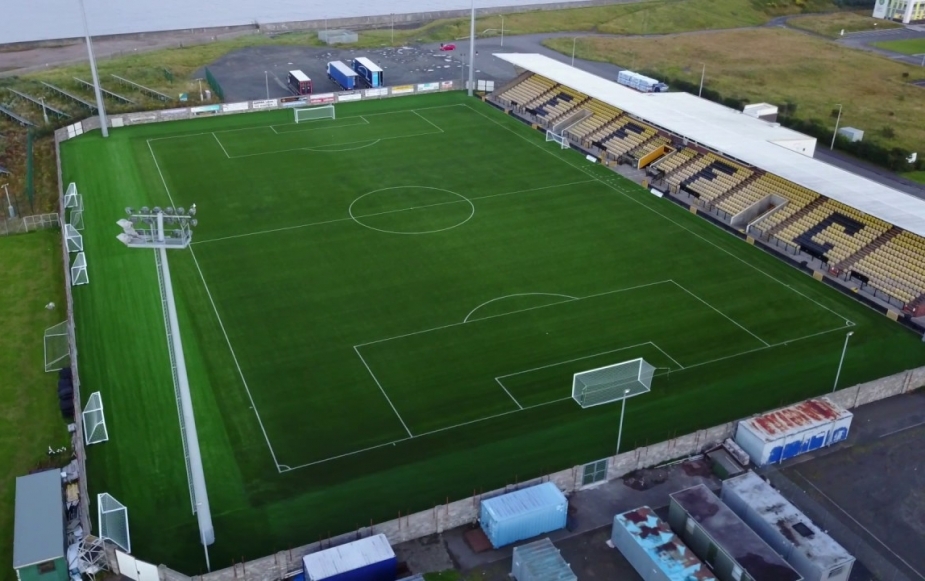We told lots of people how good the trips had been and how ‘pure’ the experience was: football as a community anchor – lifelong love conveyed in gravel-voiced bellows of ‘ya wee lazy bastard’ and ‘get tae f..’.

FLOWER OF SCOTLAND
(for Ian Laurie)

Mark Bradley
@fanexperienceco
Mark works all over Europe helping associations, leagues and clubs to understand and improve fan engagement and their match day experience.
The Fan Experience Company was founded in 2005, and in 2019/20 they oversaw the assessment of over 350 games each season in 13 countries.
Many years ago, when I began my graduate trainee programme at a Building Society in England, I met Ian. He was originally from Ayr; he’d studied History and Politics at Strathclyde University and was part of the emerging independent fan movement at his beloved Celtic, where he’d contributed to a website that I think was called, The Friday Club.
I looked up to him: not just because he was so much taller than me but, because I was in awe of him. He called me ‘wee mon’. I called him ‘big mon’ and, as our friendship grew, he decided to enrol me into the wisdom of Scottish football. ‘Let’s start with the towns where all of the teams in Scotland play’ he told me. ‘No Sassenachs have the first clue where East Fife play’ he added, by way of evidence.
I was brought up in North Durham, so I already felt a kinship with the Scots as they were not far away. Hadrian’s Wall was a short drive from Consett. I wasn’t like a modern-day Roman centurion, battling against angry Picts. I liked Scottish folk. They used to come down to Newcastle, drink a bit and shout something unintelligible. But it sounded friendly.
We used to read the Sunday Post with Oor Wullie and the Broons. My Dad was a rep and his patch included Berwick and the Lowlands. My Dad is also a Sunderland fan and had regaled me with stories about some of the great Caledonian heroes who had worn the famous red and white. For some reason the one we talked about the most was Joe Baker: the most Scottish player ever to play for England. To quote Brian Glanville, writing Joe’s obituary in the Guardian:
“He was fast, brave and tough, with good close control. He was also pretty handy, should the occasion demand it, with his fists.”
So, Ian helped me seal what was always an interest in Scotland into a real affection for Scottish football. But, as you do, especially as children arrive, work moves around the country and you find other circles, we grew apart but we soon reconnected through the magic of social media; his talent for piss-taking hadn’t been diminished by the years and, although there were a couple of attempts to meet up at game at his newly adopted East Fife (‘they play in Methil, right?’ ‘Correct, wee mon.’) we never actually renewed our friendship in person.
But I did get to visit all of those mythical football places more recently for a project looking at the potential for attendance growth and improved fan experiences at SPFL third and fourth tier clubs. Over the course of a few short years we took in games at Arbroath, Cowdenbeath, Dumbarton, Stirling Albion, Berwick Rangers, Forfar Athletic, Stranraer, Montrose, Airdrieonians, Peterhead and, finally, East Fife (we were due to meet up, but Ian couldn’t make it).
The Red Lichties know how much we loved our trip there: a friendly old fella saw us approaching the ground 90 minutes before kick-off (30 minutes too early – one thing Ian didn’t tell me) and held us in conversation while the turnstile was finally opened. It was a couple of days after my son’s 18th birthday and he was treated like a prince: someone bought him his first Belhaven (officially his first, shall we say) and the steak and black pudding pie we enjoyed should be as famous as the Smokies. It was a warm and friendly place, completely unique in ways that were hard to put into words. No doubting the quality of the football: an entertaining draw by the adjacent silver seas with a couple of sendings off, as I recall.
That was also the case everywhere else, whether it be the social club ‘by the Rock’; the warm welcome at Forthbank, when earlier it had felt like we were going to meet someone in a business park; the game of pool pre-match at Berwick and the giant tractor tyres that made everything else look subbuteo-sized at Central Park.
By nature of the ups and downs of football, we also took in lower-tier games at Ayr United, Morton, Falkirk and Raith Rovers and while they were all memorable occasions, there was a sense that the fans believed the clubs should be playing at a higher level, which, as a follower of a lower-league team who, because of history, have a ‘divine right’, etc., I could understand. They seemed to get a lot more hassle on social media, while the recent achievements of Montrose and Arbroath are welcomed more as miracles: a dividend for decades of support.
It’s no surprise that, per capita, more Scottish people attend matches than in any other country in Europe, but it’s also a little surprising that the clubs don’t seem to see what they have as capable of engaging even more people. Stadiums aren’t full, after all.
That attendance stat is one hell of a statement too, but while the Scots have never been people to get above themselves (I remember the metaphor of the abandoned drum at Stair Park) I think what these smaller clubs have is well worth shouting about.
Improvements have been made, of course. At clubs like Montrose, with only two full time members of staff (pre-Covid), the first time fan can find good pre-match info (especially on social media); excellent signage, characterised by a consistent ‘Mo’ font and a real sense of community, from the benefactors’ names on the main stand steps to the homely sense of the refreshments service (where I had some welcome hot lentil soup on a very cold day).
Arbroath’s way of presenting themselves to the world has evolved positively over the years since our first trip there in 2013. What was originally unique on account of its grainy film of a large floodlight hoving into view like something from The Day of the Triffids, has now become a website full of evidence of a pro-active grab for more attention – see the Match Day Info page, for a good example. Raith Rovers’ resourceful admin team are finding social media a good way to extend the club’s reach across Fife, while Ayr United’s affordable refreshments and genuine community ethos (see their Somerset Sleepover in 2019) almost matches the fans who, we suspect, might be the loudest 1500 people on the planet.
But there is a still a sense that Scottish football, outside of the top tier, ‘hides its light under a bushel’. We discussed this with Chris and Michael from the Scottish Football Marketing Podcast recently (you can hear that soon on all reputable podcast hosting sites – look for Fan Experience Experience) and we agreed that, while the game is unrecognisable from its younger self in terms of self-promotion and fan engagement, there is still a sense that the ‘highest per capita in Europe’ stat may be termed a sign of success rather than of what might be achieved, were we to really sell our strengths.
One of my most recent trips north was to Kirkcaldy, in January of 2019, to attend Ian’s funeral. It was a gathering of close friends where Ana and I finally got the opportunity to meet Ian’s lovely wife Jen and young son Callum – dearly loved and who had clearly been schooled in life by the ‘big mon’ himself.
I wanted to tell him about our trips; how much we’d loved those places he first told me about in 1988 and the connections that we’d made, the social club beers drunk, the pies consumed and the moments of hilarity (none more so than Ayr’s mascot trampling over two young children as he rushed to leave the field of play before kick-off at a game last Spring). I would have told him, teary-eyed, that the game in Scotland was so pure, so unique and so capable of becoming something even bigger. I’d have reached for hyperbole.
He would have looked down on his little friend and replied, ‘what a load of pish.’
© The Fan Experience Company 2020
